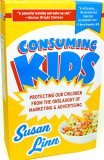Summary | Excerpt | Reading Guide | Reviews | Beyond the Book | Readalikes | Genres & Themes | Author Bio

Critics' Opinion:
Readers' Opinion:
First Published:
May 2004, 256 pages
Paperback:
Aug 2005, 304 pages
 Book Reviewed by:
Book Reviewed by:
BookBrowse Review Team
Buy This Book
The 1990s continued the assault on public funding for public institutions. When the Corporation for Public Broadcasting survived the near-fatal attack on its funding by congressional Republicans in 1995, PBS officials, facing immediate cutbacks in federal funds and the likelihood of even less government funding in the future, decided to seek other sources of revenue. They redefined corporate underwriting of programs to include the sale of actual commercial time for specific products, like Juicy Juice, as sponsors of children's programming. Now it's virtually impossible to get a children's television program produced on public television without licensing agreements. Without regard for children's health, programs like Teletubbies and Clifford the Big Red Dog31 engage in promotions with fast-food companies like Burger King, McDonald's, Wendy's, and Chuck E. Cheese.
My colleagues—health-care professionals, educators, and advocates for children—are also worried about the more generalized and insidious messages implicit in this deluge of advertising. "Ten years ago, when I asked kids how they saw their future, they talked about what kinds of professions they wanted to have," a psychologist from California told me. "But now when I ask them those questions I find myself listening to a litany of things that they want to own! It's like the substance of their lives has been replaced by the externals." As a character from the movie High Fidelity says, "What matters is what you like, not what you are like."
According to a recent poll, 90 percent of parents think that marketing in media contributes to their children becoming too materialistic. A survey of parents conducted by the Center for a New American Dream showed that 63 percent believed that their children define their self-worth in terms of what they own; 78 percent thought that marketing puts too much pressure on children to buy things that are too expensive, unhealthy, or unnecessary; and 70 percent expressed the belief that commercialism has a negative effect on children's values and worldviews.
Parents have cause for alarm. People who highly value material goods (an orientation reinforced by consumer marketing) are likely to be more unhappy and have a lower quality of life than those who value more internal or nonmaterial rewards such as creativity, competence, and contributing to the community.
As corporations vie more and more aggressively for young consumers, popular culture—which traditionally evolves from creative self-expression that captures and informs shared experience—is being smothered by commercial culture relentlessly sold to children by people who value them for their consumption, not their creativity. Consumerism as a value is marketed to children even in their toys. For the 2003 holiday season, Mattel produced at least seven Barbie Play Sets with a shopping theme. In addition to the one featured on the cover of this book, Let's Grocery Shop! Barbie, were Toy Store Barbie, Sweet Shoppin' Barbie, Shop & Style Fashion Barbie, Beauty Parlor Barbie, Chic Shoe Store Barbie, and Donut Shop Barbie.
In the long run, our children's immersion in this commercial culture has implications that go far beyond what they buy or don't buy. Marketing is designed to influence more than food preferences and choice of clothing. It aims to affect core values such as lifestyle choices: how we define happiness and how we measure our self-worth. Meanwhile, the very traits that today's marketing encourages—materialism, impulsivity, entitlement, and unexamined brand loyalty—are antithetical to those qualities necessary in a healthy democratic citizenry. Instead of being a mainstay of American life, intensive advertising to children may be eroding its foundations.
A reporter recently asked me what I see as the most destructive aspect or effect of marketing to children as practiced in the United States today. I responded that marketing succeeds by purposely exploiting children's vulnerabilities. Therefore, what you see as its "worst" effect will depend on your child's weaknesses or predilections. For example, if your child is vulnerable to overeating and poor nutrition habits, then marketing of unhealthy foods (linked to childhood obesity) seems the worst. If your child is vulnerable to eating disorders, then body-image marketing is what gets your attention. If your child is susceptible to violent messages, then you might see marketing of violent media and toys (linked to violent behavior) as the worst potential effect of marketing to children. The same is true for materialism, decreased creativity, family stress, and so on. Is obesity worse than bulimia? Is violence worse than preteen sexual precocity?
From Consuming Kids by Susan Linn, pages 1-10. Copyright Susan Linn 2004. All rights reserved. No part of this book maybe reproduced without written permission from the publisher, The New Press.





The Funeral Cryer by Wenyan Lu
Debut novelist Wenyan Lu brings us this witty yet profound story about one woman's midlife reawakening in contemporary rural China.
Your guide toexceptional books
BookBrowse seeks out and recommends the best in contemporary fiction and nonfiction—books that not only engage and entertain but also deepen our understanding of ourselves and the world around us.